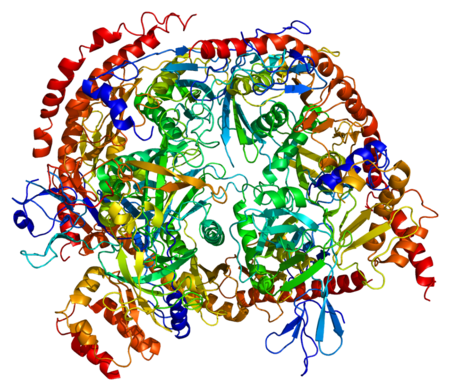عنصر إكسوسوم 3، المعروف أيضا باسم EXOSC3 هو من جينات الإنسان، وهو جزء من مركب إكسوسوم.[1]
الأهمية السريرية
الطفرات في عنصر الإكسوسوم 3 هي سبب نَقْصُ التَّنَسُّج الجِسْرِيٌّ المُخَيخِي ومرض الخلايا العصبية الحركية الشوكية.[2]
المراجع
- "Entrez Gene: EXOSC3 exosome component 3". مؤرشف من الأصل في 05 ديسمبر 2010.
- "Mutations in the RNA exosome component gene EXOSC3 cause pontocerebellar hypoplasia and spinal motor neuron degeneration". Nat. Genet. 44 (6): 704–8. 2012. doi:10.1038/ng.2254. PMID 22544365.
مزيد من القراءة
- Allmang C, Petfalski E, Podtelejnikov A, et al. (1999). "The yeast exosome and human PM-Scl are related complexes of 3' --> 5' exonucleases". Genes Dev. 13 (16): 2148–58. doi:10.1101/gad.13.16.2148. PMC . PMID 10465791.
- Lai CH, Chou CY, Ch'ang LY, et al. (2000). "Identification of novel human genes evolutionarily conserved in Caenorhabditis elegans by comparative proteomics". Genome Res. 10 (5): 703–13. doi:10.1101/gr.10.5.703. PMC . PMID 10810093.
- Brouwer R, Allmang C, Raijmakers R, et al. (2001). "Three novel components of the human exosome". J. Biol. Chem. 276 (9): 6177–84. doi:10.1074/jbc.M007603200. PMID 11110791.
- Chen CY, Gherzi R, Ong SE, et al. (2002). "AU binding proteins recruit the exosome to degrade ARE-containing mRNAs". Cell. 107 (4): 451–64. doi:10.1016/S0092-8674(01)00578-5. PMID 11719186.
- Andersen JS, Lyon CE, Fox AH, et al. (2002). "Directed proteomic analysis of the human nucleolus". Curr. Biol. 12 (1): 1–11. doi:10.1016/S0960-9822(01)00650-9. PMID 11790298.
- Raijmakers R, Noordman YE, van Venrooij WJ, Pruijn GJ (2002). "Protein-protein interactions of hCsl4p with other human exosome subunits". J. Mol. Biol. 315 (4): 809–18. doi:10.1006/jmbi.2001.5265. PMID 11812149.
- Brouwer R, Vree Egberts WT, Hengstman GJ, et al. (2002). "Autoantibodies directed to novel components of the PM/Scl complex, the human exosome". Arthritis Res. 4 (2): 134–8. doi:10.1186/ar389. PMC . PMID 11879549.
- Raijmakers R, Egberts WV, van Venrooij WJ, Pruijn GJ (2002). "Protein-protein interactions between human exosome components support the assembly of RNase PH-type subunits into a six-membered PNPase-like ring". J. Mol. Biol. 323 (4): 653–63. doi:10.1016/S0022-2836(02)00947-6. PMID 12419256.
- Strausberg RL, Feingold EA, Grouse LH, et al. (2003). "Generation and initial analysis of more than 15,000 full-length human and mouse cDNA sequences". Proc. Natl. Acad. Sci. U.S.A. 99 (26): 16899–903. doi:10.1073/pnas.242603899. PMC . PMID 12477932.
- Gherzi R, Lee KY, Briata P, et al. (2004). "A KH domain RNA binding protein, KSRP, promotes ARE-directed mRNA turnover by recruiting the degradation machinery". Mol. Cell. 14 (5): 571–83. doi:10.1016/j.molcel.2004.05.002. PMID 15175153.
- Lehner B, Sanderson CM (2004). "A protein interaction framework for human mRNA degradation". Genome Res. 14 (7): 1315–23. doi:10.1101/gr.2122004. PMC . PMID 15231747.
- Gerhard DS, Wagner L, Feingold EA, et al. (2004). "The status, quality, and expansion of the NIH full-length cDNA project: the Mammalian Gene Collection (MGC)". Genome Res. 14 (10B): 2121–7. doi:10.1101/gr.2596504. PMC . PMID 15489334.
- Rual JF, Venkatesan K, Hao T, et al. (2005). "Towards a proteome-scale map of the human protein-protein interaction network". Nature. 437 (7062): 1173–8. doi:10.1038/nature04209. PMID 16189514.

